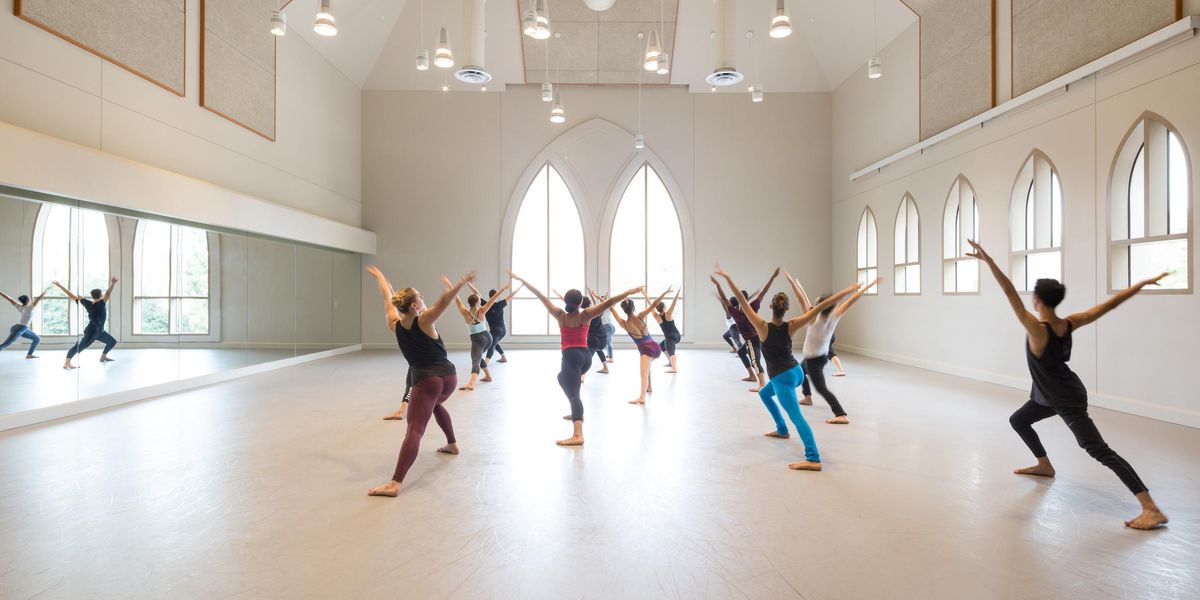How We Will Dance
Maria Kochetkova and Joan Boadarehearse in motion-capture bodysuits. Robotic cameras later moved with them to film the pas de deux. Photo by Quinn Wharton.
Some people watch Singin’ in the Rain for the love-against-the-odds story, for its delightful choreography or for its nearly unintelligible jokes at the expense of Republicans. For myself, I watch Singin’ (released in 1952) because of the way it depicts a very specific, earlier moment in time—fall, 1927—when the silent-movie industry watched in horror as Warner Bros. released the first full-length “talking picture.” The critical and commercial success of this new sound technology required a complete retooling of the film industry as production companies were pressured to create “talking” films to keep up with audience demand. Much of the humor of Singin’ is the result of critical retrospection, as when characters argue that “talking” films have no future. The movie makes comedy out of earlier generations’ inability to foresee the (retrospectively obvious) future.
As a lecturer in dance history and emerging technologies, I constantly seek out modes of choreographic creativity that point towards future, untold possibility. I do not study what dances become canonical (or not), but rather what dance technologies become canonical (or not). In the last few years, we’ve seen an explosion of activity in what could be called “dance tech.” The proliferation of internet-connected devices, from phones to watches, has radically altered how audiences consume creative content. I believe we are witnessing the emergence of novel paradigms of dance performance, powered by choreographers leveraging new media and enabled by new consumer technologies.
In many ways, the state of dance tech is embodied in the recent World Ballet Day, where five ballet companies from around the world live-streamed their activities, answered questions via a live forum, collected crowd-sourced movements and archived everything online. The event inspired over 5 million tweets from over 307,000 live viewers. (Such productions are not without precedent: Choreographer and CalArts dance division dean Stephan Koplowitz, for example, produced a daylong live-streamed dance event, during which he answered questions via a live forum, collected crowd-sourced movements and archived everything online—in 1997.)
The dance industry’s move toward live streaming and automatic online archiving stands in contrast with dance performance as it has existed for the greater part of the last five centuries. It’s the difference between dances that are gone-as-soon-as-they-exist and accessible by an elite few, and dances that exist in perpetuity and can be accessed with near universality. Dance may be a time-based art, but it can now be made to exist in the past, present and future simultaneously—danced in not three dimensions, but four.
Above: Pursuing art on her own terms: Maria Kochetkova. Photo by Quinn Wharton.
As technologies of self-expression and content consumption become ubiquitous, and more closely bound to kinesthetic experience, I believe we will see more artists like Koplowitz, who recently taught his second free online course on creating site-specific dance. There will be others like Celia Rowlson-Hall, who is creating a Kickstarter-funded feature-length dance film; Jordan Isadore, who recently live-cast a New York City performance of his Sara Du|Jour to a paying audience in Boulder, Colorado; and Benjamin Millipied, who simultaneously oversees the L.A. Dance Project, the Paris Opéra Ballet and The Amoveo Company, a multimedia production and art collective that has produced viral, dance-themed commercials for companies like Baileys and Maiyet. I believe we will see more collaborations between dance and technology companies, such as between San Francisco Ballet dancers Maria Kochetkova and Joan Boada and Tarik Abdel-Gawad (the creative technologist behind Alfonso Cuarón’s Gravity), which resulted in a dance-on-film shot by robots with cameras. These dance artists are unbound by the expectations of a traditional career, and use technology to create unprecedented opportunities to pursue their art on their terms.
In an era when many dance organizations struggle to argue their cultural relevance, emerging technologies are also having the curious effect of making our culture more dancerly. The newly announced Apple Watch, for example, will be able to interpret a variety of hand gestures, potentially making functions like accepting a call or sending an e-mail a matter of the wearer learning the necessary choreography. App designers will be able to use the motion-sensing software to create novel interfaces between the body and the device, mediated by choreographic intention. In this way, the body’s movement through space and time becomes the means by which machines and people understand each other.
As with the transition from silent films to talking pictures, moving the dancing body from the proscenium to unknown, untold platforms will be awkward and disruptive. If Singin’ in the Rain is any indication, future generations are going to find us hilarious. But this tectonic shift is already underway, and has already allowed millions of new people to interface, literally, with choreography. Because of this I believe the future of dance in our world is quite bright, indeed.
Not All Technology Takes Off
The technology of the pointe shoe came to dominate the romantic sensibility of fairylike weightlessness, to the extent that it was eventually used by fairies and nonfairies alike—and indeed came to symbolically stand in for the very art form of ballet itself. Yet at around the same time pointe shoes were being invented, the puppeted ballerinas of Didelot’s early 19th-century Russia were attached to a pulley in order to create the same illusion. In retrospect, the pointe shoe seems obvious and the “wired” ballerinas laughable, but this was hardly the case in that historical moment when both technologies were vying to make women seem as though they could fly.
Sydney Skybetter is a founding partner of The Edwards & Skybetter | Change Agency, serves on the faculty of The Boston Conservatory and lectures on dance at Harvard University.




